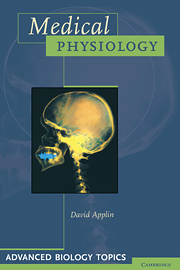Book contents
- Frontmatter
- Contents
- 1 What is disease?
- 2 Understanding the immune system
- 3 The control of bleeding
- 4 Heart disease
- 5 Physiological effects of exercise
- 6 Food and health
- 7 Diseases of the gaseous exchange system
- 8 Kidney failure
- 9 Fertility and contraception
- 10 The brain: memory, ageing and the effects of drugs
- 11 Medical genetics
- 12 Biotechnology and medicine
- Index
- Frontmatter
- Contents
- 1 What is disease?
- 2 Understanding the immune system
- 3 The control of bleeding
- 4 Heart disease
- 5 Physiological effects of exercise
- 6 Food and health
- 7 Diseases of the gaseous exchange system
- 8 Kidney failure
- 9 Fertility and contraception
- 10 The brain: memory, ageing and the effects of drugs
- 11 Medical genetics
- 12 Biotechnology and medicine
- Index
Summary
What is heart disease?
The walls of the heart are very thick. Food and oxygen dissolved in the blood cannot pass quickly enough from inside the heart to all of the heart muscles by diffusion alone. The coronary arteries running over the surface of the heart transport blood, carrying dissolved food and oxygen, to the heart muscles.
The smooth inner wall of healthy blood vessels allows blood to flow easily through them. Anticoagulants such as heparin (from the liver) and prostacyclin (from the lining of blood vessels) prevent blood from clotting inside vessels. However, deposits of a fatty material called plaque can roughen the inner wall. As plaque builds up it causes a type of ‘hardening’ of the arteries called arteriosclerosis. The roughened blood vessels become narrower, blood flows through the vessels more slowly and the release of prostacyclin is inhibited. As a result:
platelets (page 35) clump together (agglutinate);
thromboplastin is released – the enzyme that begins the process of blood clotting.
These events increase the risk of blood clotting and blocking blood vessels. If an artery is blocked completely, then food and oxygen cannot reach the tissue that the artery supplies. The tissue is damaged and may die (infarction). The clot is called a thrombus and the blockage a thrombosis.
Sometimes a thrombus may be dislodged and carried in the bloodstream. The mobile thrombus is called an embolus.
- Type
- Chapter
- Information
- Medical Physiology , pp. 39 - 48Publisher: Cambridge University PressPrint publication year: 1997



